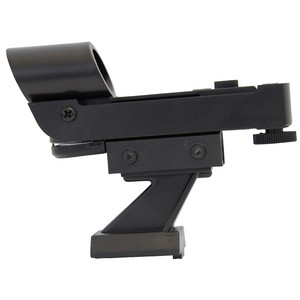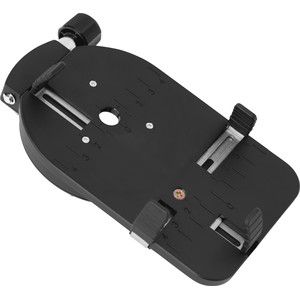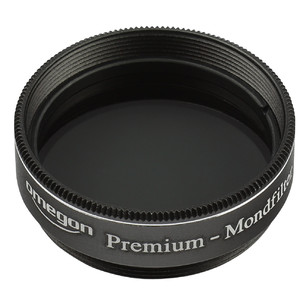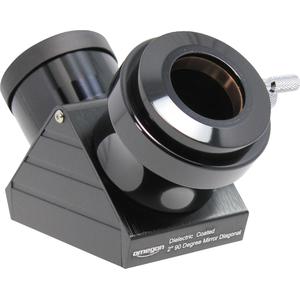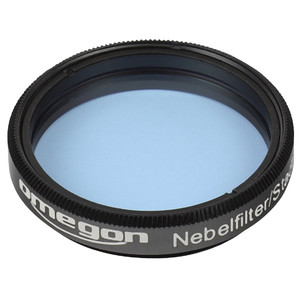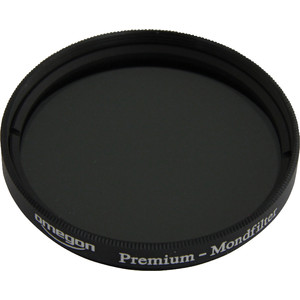Wonderful astro photos with a professional telescope
This Cassegrain telescope was created to make better, more beautiful astro photos. Pictures have more contrast and a sharper field of view right up to the edge. It’s no surprise that professional astronomers almost exclusively use this telescope design. Now this technology is affordable for amateurs too. Can you imagine if you too could produce astro photos to a professional standard?
The advantages at a glance:
- Primary mirror with 94% reflection for brighter images than a standard telescope.
- 8 light baffles for more contrast and sharper images.
- Quartz mirror: better imaging whilst the telescope is cooling down. Focus remains stable even over a long evening of photography.
- Crayford focuser with 2” and 1.25” adapters: no mirror shift and greater back focus. For astrophotography: simply attach your SLR camera using the 50mm and 25mm extension connectors supplied.
- Full illumination with APS-C sensors or sensors with up to 30mm diameter
Who is this telescope suitable for?
A Cassegrain telescope is a system for more beautiful astro photos that you can be proud of. Many telescope designs are supposed to do everything from photos to visual observations. But that’s not entirely correct: everyone knows that there is no such thing as an expert on everything. For this reason, this telescope has been created specifically with astrophotographers in mind. We don’t want an average telescope for average photos, but instead a capable tool for astrophotography. For this it is perfect - it will produce first-class images of the night sky for you.
Full illumination for most sensors
The Omegon Cassegrain telescope is a master photographer of the night sky. Attach cameras with sensors up to 30mm diameter and benefit from illumination without vignetting.
Why is a Cassegrain better than a Schmidt-Cassegrain telescope?
The Omegon Cassegrain’s primary mirror is parabolic and the secondary mirror has a hyperbolic shape. This means fewer aberrations: the image area is flatter, there is less coma and the sharpness of the field is considerably higher. For you that means: you will take photographs with significantly better images of stars and with visible fine detail. All in all your astro photos will look fascinating.
That’s better than a SC telescope:
- Sharper pictures
- No lens in the optical path, and so an infra-red filter is not needed for planet photography
- Larger usable image field for astrophotography with fewer optical aberrations
- Minimal obstruction, giving you more contrast
- No chromatic aberration
- No ghosting on the image
Quicker cooling times
Do you have to set the telescope up and then wait an eternity? It doesn’t have to be that way. The quartz parabolic primary mirror hardly changes its profile during the cooling phase and is considerably more stable than Pyrex. The advantage for you: a crystal-clear image from the very first minute.
Quartz primary mirror with 94% reflection
94% enhanced coating: because every percentage point counts where brighter pictures with more contrast are concerned. This mirror is a strong contender as it offers 6% more reflection than the standard variation built into most telescopes.
You can look forward straight away to brighter images and faint deep-sky objects.
Crayford: more than enough focus
Attach any accessory to your telescope and don't worry about focus. With most cameras it’s no problem to get sharp images; the reason for this is the long back focus. You can also use a reducer or even binoculars.
8 lens hoods
The 8 lens hoods ensure more contrast for sharper images in which you can see more detail.
No mirror shift
Ping pong was great fun, but as a photographer catching planetary nebulae in your eyepiece is not such a great game. The good news: it's no longer necessary. Because unlike a SC telescope this Cassegrain has a fixed parabolic primary mirror, so the object doesn’t jump across the eyepiece, it stays fixed on the spot.
What objects can you photograph?
The Omegon Cassegrain is a master for all compact objects in the solar system or in interstellar space. Even small nebulae can be reached with the long focal length. That makes this telescope especially good for:
- lunar craters
- planets
- distant groups of galaxies - planetary nebulae
- globular star clusters

